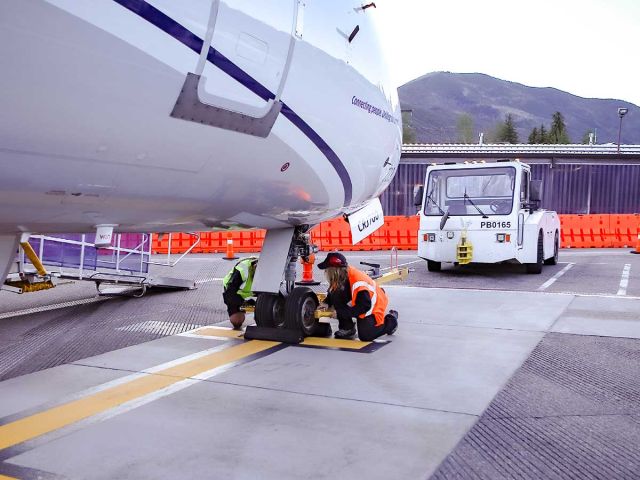The last major airfield and terminal upgrades were completed more than 40 years ago. The airport is out of date, and improvements are needed to meet current airport standards and the needs of residents. We must take action now!
We need to make critical improvements to our airport that upgrade and modernize air traffic safety which will ensure a wider separation of planes during taxi, takeoff, and landing.
With these airport improvements, airlines will be more likely to offer direct, non-stop flights, making it easier to fly in and out of Aspen-Pitkin County Airport.
November BOCC Airport Ballot Issue Explained
The Pitkin County Board of County Commissioners will have an initiative on the November ballot – Referendum 1C – BOCC Referred Home Rule Charter Amendment.
Referendum 1C authorizes the board of county commissioners to use federal funds to improve the airport, which has not been updated in 40 years. 1C will modernize the airport, increase safety, and reduce airport carbon and noise pollution.
OFFICIAL BALLOT LANGUAGE
Referendum 1C – BOCC Referred Home Rule Charter Amendment
Shall there be an amendment to the Pitkin County Home Rule Charter to reaffirm the Board of County Commissioner’s existing authority to approve and implement a physical layout, including any runway expansion and relocation, and attendant regulatory plan for the Aspen/Pitkin County Airport that meets federal and local requirements; improves safety, reduces air, noise, and carbon pollution; decreases vehicle traffic to and from the airport; updates infrastructure and manages growth consistent with community values; and to take all necessary actions to secure and maintain federal funding for such improvements in accordance with the provisions of BOCC Resolution No. 080-2024.
In the News
A Whole Lot of People for a Better Airport is endorsed by Aspen Chamber Resort Association [ACRA], Pitkin County Democratic Party & Pitkin County Republican Party
Aspen Chamber Resort Association hosted discussions on the 2024 election, focusing on Aspen/Pitkin County Airport ballot measures. Watch Now »


Federal Aviation Administration expresses concern over ballot question 200 in letter to Pitkin County
ADDITIONAL RESOURCES
-
BOCC Approved Common Ground Recommendations
-
Final Report of the Airport Vision Committee Process
-
737’s at Aspen – Myth Versus Reality
-
Aspen/Pitkin County Airport Website
Vote NO on 200
Pitkin County Democrats, Pitkin County Republicans and Aspen Chamber Resort Association have stated a “No” vote on 200 is the best choice for Pitkin County. By voting “No,” we can:
- Build a modern, safer airport that meets today’s standards.
- Reduce carbon emissions and noise pollution.
- Decrease vehicle traffic to and from the airport.
VOTE YES on 1C for a Better Airport and Say Yes to:

SAFETY
An airport that prioritizes safety in the air and on the ground.
Safety in the air and on the ground is the No. 1 Core Community Goal for the Aspen/Pitkin County Airport and for the FAA. To make ASE as safe as possible, the FAA is mandating that we widen the runway and increase the separation between the runway and the taxiway. This, coupled with technology and procedural improvements, will increase safety for all aircraft flying in and out of the airport.

MANAGED GROWTH
An airport that honors the County’s growth target, not adds to it.
Improving the airport’s runway to meet FAA safety standards does not mean ASE will be inundated with larger planes and increased passenger volume. Tourist numbers in the valley are principally controlled by bed base (the number of hotels and vacation rentals), not the airport’s passenger capacity. The plan for “flexible gates” at the new terminal means that if a plane larger than the CRJ700 or Embraer E175 comes in, the number of gates will decrease, meaning fewer commercial planes can land at the airport.

FUNDING
An airport with a secure financial future.
Long-term financial responsibility and stability for the airport require utilizing federal grants to avoid jeopardizing air service at ASE or burdening local taxpayers. This means partnering with the FAA to reinstate funding, which is currently suspended, to accomplish our community’s goals.

ENVIRONMENTAL STEWARDSHIP
An airport that sets the global standard for sustainability and emissions reduction.
We believe ASE can be a cutting-edge facility that demonstrates how airports, airlines, and others in aviation can play their part in the green transition. This will include reducing greenhouse gas emissions and other pollution by 30% and building a net-zero terminal incorporating every climate-friendly technology possible, meaning 100% electric with no fossil fuels used to run anything other than the planes.

TRANSPORTATION CONNECTIVITY
An airport that connects to an effective mass-transit system.
Getting more visitors to use mass transit to and from the airport represents an enormous opportunity. With today’s terminal and bus system, fewer than 5 percent of travelers use the local buses (RFTA). Luggage-compatible buses and a transit center incorporated into the new terminal could dramatically increase that number. The relatively short round trips between the airport and the towns of Aspen and Snowmass also make those routes among the first that could be served by electric buses.

REDUCED NOISE
Reduce noise by at least 30%.
Airport noise is not going away, but it can be reduced significantly by accommodating (and incentivizing) the cleanest, quietest aircraft possible, which require a wider runway to accommodate their wider wingspans. Other measures to mitigate sound impact include maintaining and strictly enforcing the curfew and replacing gas-powered generators with quiet electric ones.
Get Informed: Key Questions Answered
1. I’m hearing a lot about the airport but haven’t been paying attention. What’s going on?
The Federal Aviation Administration (FAA) requires that airports maintain an approved “Airport Layout Plan” (ALP) that shows existing and planned airport facilities, including runway/taxiway layout and plans for the tower and terminal, aircraft parking spaces for both private and commercial aviation, and more. Pitkin County needs a new ALP, and the FAA requires that it meet certain standards, mostly related to safety, in order to continue receiving federal airport funding. (Because airports incur huge capital costs like runway and terminal construction and maintenance—costs that are hard for communities to cover—airports receive large amounts of federal money. An FAA-approved ALP is required to receive those funds.) In 2019, to ensure Pitkin County’s new ALP would best align with community values, the county appointed 123 citizens to serve on five working groups over fifteen months to create the “Common Ground Recommendations.” Since then, the BOCC has been working to get FAA approval of an Airport Layout Plan that would deliver those Common Ground goals set by our citizens.
2. Is there any urgency to the ALP approval?
Yes. The airport is in bad shape. No one disputes this. The terminal is woefully inadequate for both travelers and airport staff. It needs to be completely replaced. The runway is suffering after years of patchwork fixes and needs a complete rebuild. These projects will cost hundreds of millions of dollars, money the community does not have. The FAA will only fund the new runway if we present them with an ALP that meets federal aviation standards. Fortunately, the County’s submitted plan is acceptable, and the FAA is considering it right now.
3. What did the Common Ground Recommendations ask for?
The Common Ground Recommendations included 14 suggestions and can be accessed online. Their big-picture objectives, however, can be summed up by the recommendations’ four Core Community Goals:
- Safety in the air and on the ground.
- Reduce greenhouse gas and other pollutant emissions by at least 30%.
- Manage the growth of airline enplanements to be consistent with community growth management plans.
- Reduce noise by at least 30%.
Other specific Common Ground recommendations include seamless ground connectivity to reduce vehicle trips to and from the airport, building a new net-zero terminal that serves as a model for the world and reflects our community’s values and our connections to arts and culture, and a dramatically improved experience for both travelers and airport staff.
4. Your coalition name asks for a 21st Century Airport. What does that mean?
- A 21st Century airport is one that’s served by the cleanest, quiet aircraft possible as those aircraft come online (including aircraft that are used today but can’t land in Aspen), as well as electric, zero-carbon planes when they finally become a reality.
- It’s an airport that is connected to a mass-transit system that offers the most convenient option for travelers and airport staff getting to and from the airport.
- It’s an airport whose net-zero terminal incorporates every climate-friendly technology possible–which will mainly mean being 100-percent electric with no fossil fuels used to run anything other than the planes.
- It’s an airport that sets the global standard for sustainability and emissions reduction.
- It’s an airport that supports the County’s growth targets, not adds to them.
- It’s an airport that is a model for the world from a climate perspective.
Every item on this list is only possible with FAA funds
5. How can we reduce greenhouse gas (GHG) emissions at our airport?
Newer aircraft are generally more fuel efficient and emit lower GHG emissions. By modernizing our airport, we will be able to accommodate the aircraft of the future, which will be far less polluting.
Short Term: Some low-emission planes are already available. The Airbus A220-100, for example, emits less than half the carbon pollution-per-passenger-mile of the CRJ700 that currently serves Aspen — and the citizens of the Airport Vision Committee suggested the A220-100 as the ideal plane to serve Aspen now. (Delta is already flying it, but the plane can’t serve Aspen today because its wingspan exceeds 95 feet, the maximum allowed on today’s airport.) Other emission reducing measures include replacing auxiliary power units (APUs) with clean electrical plug-ins for parked aircraft; this would significantly reduce the pollution and fumes that airport neighbors breathe today.
Intermediate Term: We can reduce aircraft emissions though strategies like carbon-based landing fees for airliners and private aircraft. We could also build a right-sized, net-zero new terminal, electrify the airfield with 100% renewable power, require the use of sustainable aviation fuel, install an on-site solar farm, and employ carbon-offset credits.
Note that strategies like a carbon-based landing fee will require policy change at the federal level, but Aspen and Pitkin County have successfully achieved comparable federal policy changes in the past, and we intend to be a model for how other airports can help our nation address the existential crisis of climate change. This is a policy change we can and must win.
Long Term: Low carbon and net-zero planes of the future will likely use electric propulsion, hydrogen, sustainable aviation fuel, or a hybrid of these. These future aircraft, whether “narrow-body” or “blended-wing,” are predicted to have one thing in common: wider wingspans. Aeronautical engineers use terms like “longer, lighter, thinner” to describe plane wings of the future, which will almost certainly exceed 95 feet in wingspan. If we’re serious about addressing climate change, wider wingspans are a given. They are an essential component of becoming the greenest airport in America.
6. How can we achieve a quieter airport?
Aircraft with lower greenhouse gas emissions are normally quieter, so much of the explanation in #5 (above) applies equally to reducing aircraft noise.
For example, today’s Airbus A220-100, which has half the carbon emissions of the CRJ700, is also significantly quieter than the CRJ. On the private aircraft side, a larger plane like the Gulfstream G650 is significantly quieter and more fuel efficient than the G4, which is common at our airport today, yet has the same passenger count. ASE’s current prohibition on wingspans greater than 95 feet prevents newer planes like the A220-100 and the G650 from landing here, but as discussed above, we will ultimately need wider wingspans if we are to achieve our climate change goals.
The Common Ground Recommendations contain other noise reduction strategies:
- Replacing noisy auxiliary power units (APUs) with clean and quiet electrical plug-ins for parked planes
- Increasing aeronautical spacing (a safety measure) for planes in the air
- Providing berms and sound walls around the airport
7. Will the new Airport Layout Plan create major changes to the airport?
It will. Plans include a new runway, a new green terminal with fewer gates, a wider and safer separation between taxiway and runway, changes to the ramp (aircraft parking area), sound berms to reduce noise, and many other improvements across the airfield. The new ALP will create a modern airport at what’s called an Airport Design Group III (ADG-III) standard. An airport’s “design group” determines the maximum size and weight of the aircraft that can serve it. Our airport currently sits between an ADG-II and an ADG-III. Rather than the 79-foot maximum wingspan allowance of an ADG-II airport or the 118-foot maximum allowance of an ADG-III, our airport allows wingspans up to 95 feet. Call us an “ADG-II-plus.” We have occupied this in-between spot due to modifications to FAA standards that have been in place since 1999. But the FAA is doing away with modifications to standards as a matter of federal policy. The agency will not approve an Airport Layout Plan that includes them. So we have a choice: Go to full ADG-III or drop to ADG-II.
8. But won’t going to an ADG-III standard allow wider wingspans and bigger planes?
Wider wingspans, yes. We need them. Aeronautical engineers agree that wider wingspans are in our future, no matter what, and they are certainly essential if we are to reduce airline greenhouse gas emissions. (See the greenhouse-gas discussion in #5, above.)
But even though an ADG-III airport could allow for planes with wingspans up to 118 feet, there’s ample evidence that larger planes with dramatically higher passenger volume don’t make economic (or aeronautical) sense for Aspen and that the airlines won’t bring them here. Based on the planes Aspen’s airlines currently own and have ordered for the future, it’s clear that Aspen is best served by regional aircraft, not large mainline planes.
Possibly as soon as this fall, United Airlines and SkyWest will begin using the Embraer E175 as their plane for Aspen, replacing the Bombardier CRJ700 that is currently the only commercial airplane that serves us. American Airlines is showing a similar likelihood. The E175 is almost exactly the same size as the CRJ700, but it’s more polluting and slightly noisier. It’s main appeal is that it is brand new and allows the airlines to retire the aging CRJ700’s.
Delta’s plane of choice is the Airbus A220-100. It has a higher passenger count than the CRJ700, but it is dramatically quieter and cleaner, so much so that this plane was deemed the ideal future plane for Aspen in the Common Ground Recommendations. In Delta’s configuration, the A220-100 seats 109 passengers, which is 33 more than the CRJ-700, but only 9 more than the BA-146 that served the Aspen Airport for close to 20 years. Its scale fits our community character.
9. What about bigger private planes?
Only a handful of “big privates” are being used in the U.S. anymore. One or two land each year at ASE, and no one has ever noticed. The next generation of private planes have identical passenger counts to the biggest private jets that fly into Aspen today, but they are significantly quieter and more fuel efficient, in part due to their wider wingspans. This point is overlooked by some opponents of a modern airport: achieving climate goals requires more efficient planes with longer wings, whether private jets or commercial aircraft. But a smaller runway won’t accommodate those modern planes.
10. Will a new airport spike growth and increase crowds?
No, the new airport plan contains stronger growth management measures than today’s airport. The County’s new terminal plan calls for six gates (expandable to eight in the future). By contrast, today’s airport already has eight gates, plus two additional airline parking spaces.
Today’s “gates” are defined simply by paint on tarmac and moveable sets of stairs that attach to a plane; their number could be expanded in a few minutes with a paintbrush. The BOCC’s Common Ground resolution calls for six in the new airport, expandable to eight gates “if necessary for safe and efficient airport operations.” The expansion to eight would require separate approval by both the citizens’ Airport Advisory Board and the Board of County Commissioners by resolution or ordinance.
In addition, the new airport plan calls for “Flexible Gates.” These gates “flex” down for larger aircraft (e.g. the Airbus A200-100), thus keeping the airport’s total enplanement/deplanement capacity at approximately the same level, regardless of aircraft size. Bottom line: the number of gates and total enplanements will be right-sized to match Pitkin County’s growth management guidelines.
Growth in this valley is principally controlled by bed base, not the airport’s passenger capacity. Close to 50 percent of all local and out of state visitors to the Roaring Fork Valley use airports other than the Aspen-Piktin County Airport. Increased flight capacity into our would materially reduce the number of vehicle trips to and from Denver, Eagle, and Grand Junction.
Visitor growth is controlled by county and municipal governments. Almost every town in our valley has made efforts to stem the growth of short-term rentals that convert residential housing into lodging. Our communities are making smart, concerted efforts to manage their growth as it relates to tourism. Pitkin County recently completed a large-scale study with a community volunteer board to create the Pitkin County Growth Management Plan. That work made clear that a big driver of vehicle trips and the sense of busyness in the valley ties directly to the construction and servicing of the residential sector, particularly large homes.
11. Why do we need the FAA to approve our plans for the airport? Why can’t the community just tell the FAA what it wants?
The FAA has stated in writing that because we have failed so far to comply with federal airport design requirements, we have been cut off from federal funding to rebuild our deteriorating runway, and we will lose additional funding in the future.
The FAA sets certain rigid standards around safety (which takes the form of runway/taxiway separaton, runway width, etc.) and accessibility (which is included in the FAA’s required enplanement forecast). The FAA won’t budge on those criteria. If a community ignores those requirements, the FAA will pull its funding. This has now begun, and it puts our community in a precarious financial situation in the immediate term and a truly untenable one in the future. We are now on the hook for millions of dollars in annual maintenance–again, the runway is failing and requires regular fixes–and later, the entire cost of a new runway and terminal, which will run into hundreds of millions of dollars.
12. Is the airport at risk of losing federal funding?
It already has. The airport is no longer receiving federal funds and the community is spending millions to do annual maintenance on the runway. This is not a question of whether the FAA will blink if the community sticks to its guns: it already won the staring contest, and the money has been pulled. The FAA has made it perfectly clear in writing, in person, and in Washington D.C. that they will no longer fund repairs or maintenance for ASE until the airfield plan is in compliance with FAA requirements.
13. What would happen to traffic, the economy, jobs, and crowding if we don’t improve the airport?
If Pitkin County’s Airport Layout Plan does not meet FAA requirements and is therefore rejected, the FAA will likely downgrade the Pitkin County Airport to Airport Design Group II status. That would mean commercial airlines could not fly their next generation planes into town. The only commercial plane that could still land here would be the aging CRJ 700. Because its CRJ700s are not so problematically old, American can probably continue to fly CRJ700s for some time, but certainly not United and probably not Delta. One local aviation expert said this about an ADG-II airport designation: “In my opinion, the threat of a downgrade to ADG-II is effectively a poison pill for the future of commercial flights at ASE. It may not die immediately, but a slow and painful death is almost certain over a period of time as capacity would decline and commercial flights into ASE would become increasingly unaffordable for a product that’s going to become increasingly dated and less reliable (due to it being tied to the CRJ700).” The result of a slow decline in commercial air service would be increased costs, loss of visitation, loss of jobs, and therefore the increasing privatization of the airport.
Losing a piece of commercial air service in the event of a downgrade to ADG-II status would also increase traffic and congestion as more people drive from Eagle, Rifle, and Denver.
14. What major projects are included in airport improvements? And why does the County want to do them now?
The three biggest physical projects are increasing the runway-taxiway separation, widening the runway, and building a badly needed new terminal building. The FAA requires the first two in order for our airport to conform with the FAA’s “Airport Design Category (ADG) III” safety standards. The Airport Layout Plan needs to be completed now to avoid losing federal funding that expires in 2026.
15. When will these projects happen?
Building the entire new airport will likely take around 5 – 9 years (depending on how much of the work can be done simultaneously and how much must be constructed serially). Runway reconstruction could happen as soon as 2026.











